GUATAPE, COLOMBIA - I’ve only climbed 150 of the 740 steps required to reach the top of a mammoth monolith known as El Peñol and already I’m exhausted. My aching knees are in need of a Ben Gay fix. My heart is pounding so hard I think it’s about to leap out of my chest. Sweat is pouring off my brow like a water fall. My feet and legs feel like lead weights.
“Keep climbing,” a voice from behind encourages me.
Okay, only 590 steps to go.
“Mon dieu, I think I’m going to die,” I hear the French tourist say as I pass her a few seconds later on the narrow cement stairs that have been carved into the back end of the granite mountain like a spine.
As I climb higher, the rarefied air at around 2,100 metres starts to make me feel light headed. At step 250, I move aside to let others pass and take the opportunity to admire the glorious valley views one gets from La Piedra del Peñol, the Rock of Guatape.
By the time I reach step 350, where a ledge allows people to cross over to a descending staircase, I bail out. I can’t go any further. I surrender to mighty El Peñol.
When I reach the bottom of the 10-million-year-old humped-back mountain that’s located in a rural area of Colombia called La Piedra, my guide Juan is waiting.
“You are not the first and won’t be the last who does not make it to the top of El Peñol,” he says while I admire two large faded letters — a “G” and a “U” — painted on the side of the national landmark.
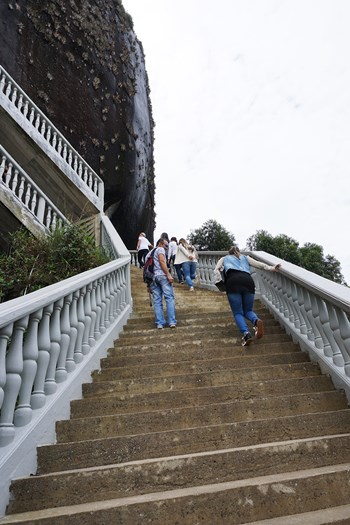
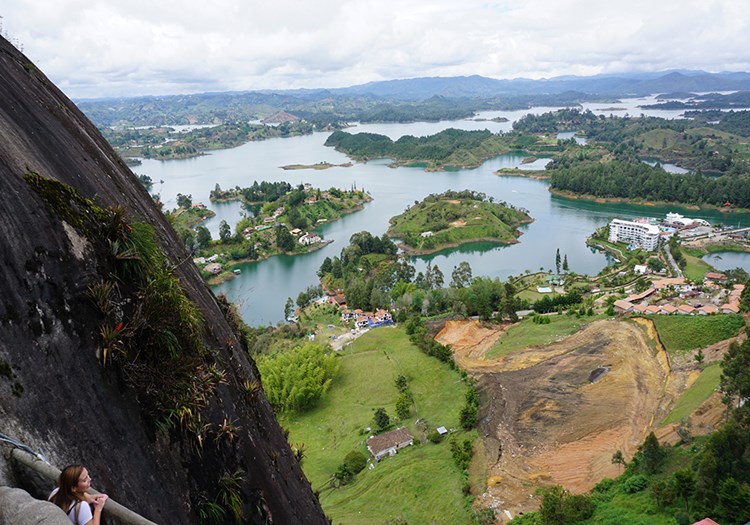
Left: It takes 740 steps to reach the top. Right: Views from anywhere on the mountain are spectacular.
“Ownership of the rock has always been in dispute between the (neighbouring) towns of Guatapé and El Peñol,” says Juan, “and one night some workers from Guatapé climbed the mountain and started writing the town’s name on the side. By the time the people from El Peñol saw what was happening and stopped it, those two letters were already etched. They are fading now but it will take many years before they disappear.”
The Tahamies people worshiped the 220-metre-high rock that has become the biggest tourist draw to this stunning areas of Colombia.
Most of the original town of Guatapé was flooded to make room for the giant hydro electric project that now produces much of the electricity for Medellín, the country’s second-largest city that’s a 90 minute drive east of here.
Guatapé is also known as the “Garden of Colombia” because 60 per cent of the country’s flowers are produced in the region — most are exported to the United States.
This area of Colombia has also become a weekend getaway for the people of Medellín and in recent years some upscale accommodation have opened, like the Hotel Luxe by Charlee. The resort offers long term villas and a new 116 resort style hotel, which is perched on a hill overlooking the surrounding brilliance and El Peñol, will soon open. Right now, a patio restaurant that makes the best pizza in Colombia is where travellers like me are welcomed.
We leave El Peñol and make our way to lovely Guatapé along some winding rural back roads bordered by stunning rolling terrain. Juan describes Guatapé as the “most colourful town in Colombia and one of the most colourful in the world” and as the town’s pastel-coloured homes come into view, it’s easy to see why the guide is so enthusiastic to show off this historic city.
“Make sure you take notice of the zocalero” — paintings that run along the sockets (lower part) of homes and shops that tell the story of Guatapé and the people who live here.
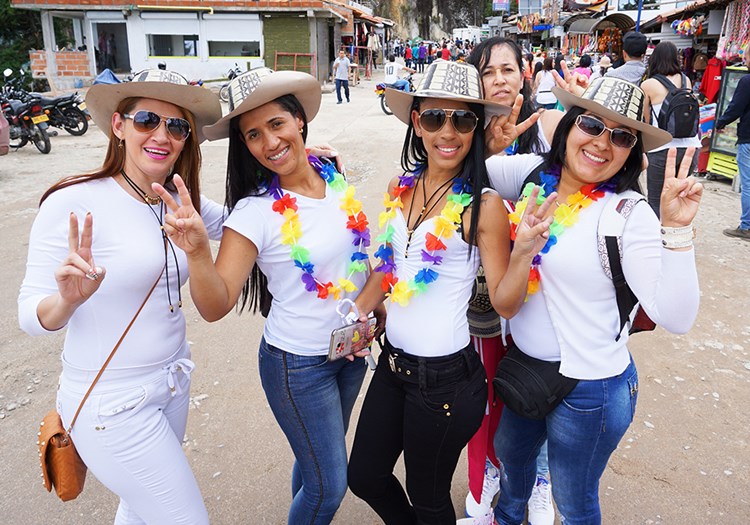
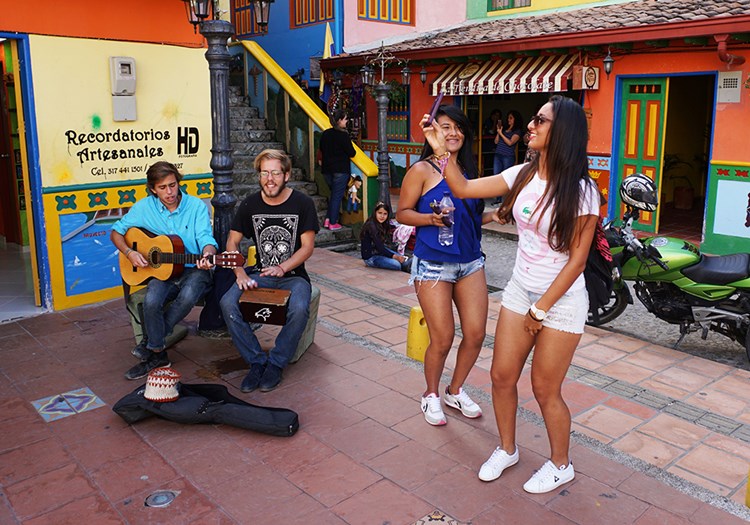
Left: People celebrate their climb to the top. Right: Guatape is a party city.
“No one is quite sure when the zocaleros first appeared but now just about every home in Guatapé has one,” says Juan as we reach a small square where singers are serenading a small crowd.
One of the most famous zocaleros is the one that portrays the history of Colombia’s famed “silletero” — the indigenous people of Colombia who were forced to carry Spaniards around on their backs.
“When the Spanish first arrived (in the 15th and 16th centuries) they were afraid to put their feet on the ground because of snakes and other creatures lurking in the jungle.
“So they forced the indigenous people to carry them around on their backs in a crude wooden chair,” says Juan. “That was one of the cruelist times in our history.”
Today descendants of the indigenous people continue the silletero tradition, but instead of people, they carry huge bouquets of flowers — some weighting as much as 60 kilograms — in parades, like Medellín’s famed Flower Festival, which is held every summer.
“That’s our largest festival and the silletero always end the parade with their flower baskets.”
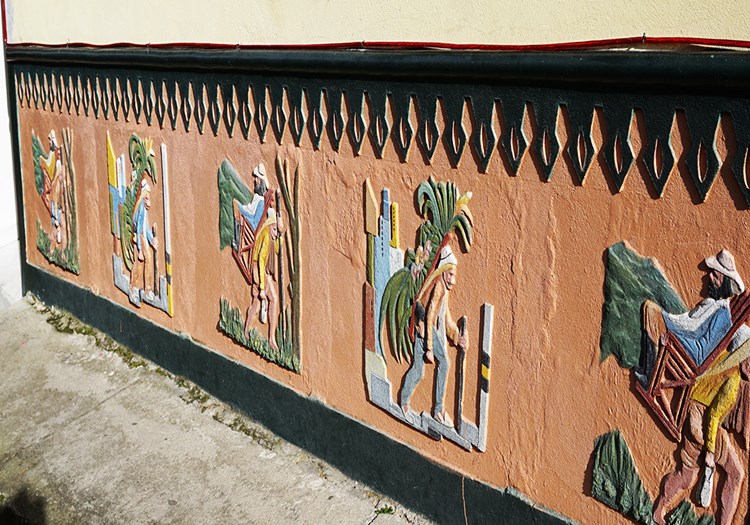
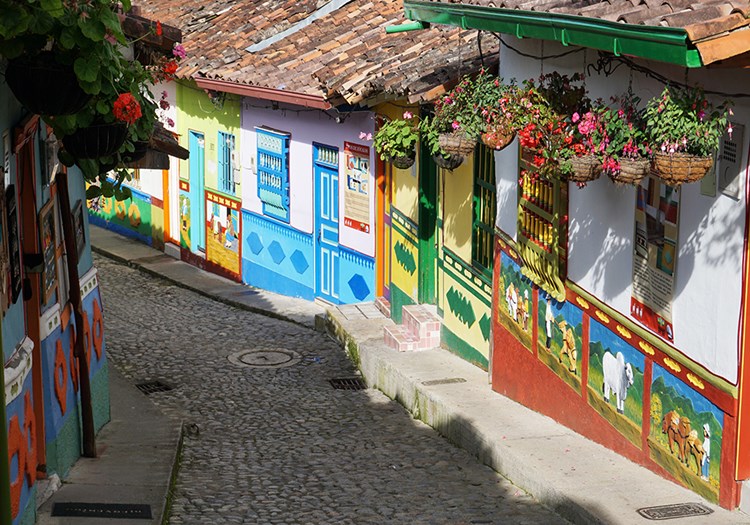
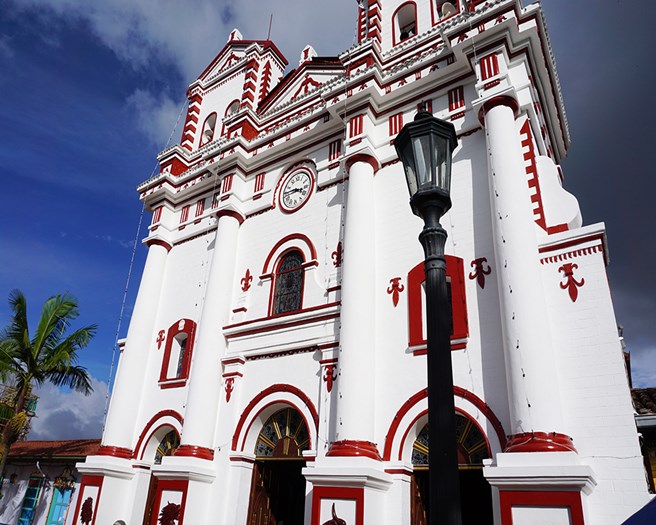
Left: History is written on the walls. Middle: Streets of Guatape are lovely. Right: Church Nuestra Senora del Carmen dominates main square.
On weekends, Guatapé’s waterside boardwalk fills up with lots of visitors from cities like Medellín, who like to take boat tours on the lake created as part of the hydro damn. One tour includes a visit to La Manuela, Pablo Escobar´s former lakeside mansion which was bombed by federal troops at the height of Colombia’s notorious drug wars. A canopy zip line over the lake proves popular with the younger set and the more mature like to hang out in the town’s lovely main square, which is surrounded by quaint cafes and the handsome church of Nuestra Señora del Carmen. The stunning white church is trimmed in crimson and offers a lovely wooden interior, making it one of the most beautiful chapels in all of Latin America.
Guatapé is full of surprises, just like Colombia.
About the Author
Marc Atchison is a veteran journalist and a seasoned traveller with more than 20 years of travel writing experience. As the former Travel Editor of the Toronto Star, Canada's largest newspaper, and now Editor-in-Chief and Senior Writer for TraveLife magazine (Canada) and travelife.ca, Marc has been to over 100 countries in the world. Japan is one of his favorite destinations and he's been there on numerous occasions.